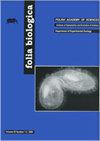如何界定神经母细胞瘤患者的“超高危”亚群?
IF 0.8
4区 生物学
Q4 BIOLOGY
引用次数: 3
摘要
神经母细胞肿瘤表现出异质性,导致不同的治疗结果。神经母细胞瘤可分为低、中、高风险三大类。最近对新基因的鉴定提高了新的生物标志物识别亚风险群体的可能性。在这项回顾性横断面研究中,我们旨在评估在临床情况不同且预后非常差的高危组中定义超高危亚组的新生物标志物。分析25例低危组和29例高危组患者在RNA水平上ALK、ATRX、HIF1a、HIF2a (EPAS)、H2AFX和ETV5基因的表达。免疫组化检测ALK蛋白表达水平。根据国际神经母细胞瘤危险组分层系统确定患者的危险组。采用Spearman相关分析和Mann-Whitney-U非参数检验评估各组间表达水平的重要性。P < 0.05为差异有统计学意义。通过ROC曲线分析检验结果的敏感性。除ETV5外,所有分析的基因在高危组中的表达均高于低危组。将超高危组与高危组进行比较,发现ALK在超高危组中高表达。我们的研究结果表明,ALK可能是一个候选基因,其mRNA表达水平可以区分非家族性神经母细胞瘤高危组患者的超高风险亚组。本文章由计算机程序翻译,如有差异,请以英文原文为准。
Questioning How to Define the "Ultra-High-Risk" Subgroup of Neuroblastoma Patients.
Neuroblastic tumours exhibit heterogeneity, which results in different therapeutic outcomes. Neuroblastoma is categorized into three major risk groups (low, intermediate, high risk). Recent identification of new genes raised the possibility of new biomarkers to identify sub-risk groups. In this retrospective cross-sectional study, we aimed to assess new biomarkers defining the ultra-high-risk subgroup within the high-risk group that differ in clinical situation with very bad prognosis. Twenty-five low- and 29 high-risk groups of patients were analysed for their expression of ALK, ATRX, HIF1a, HIF2a (EPAS), H2AFX, and ETV5 genes at the RNA level. Immunohistochemistry was performed to confirm the protein expression level of ALK. The risk group of patients was determined according to the International Neuroblastoma Risk Group Stratification System. Spearman correlation analysis and Mann-Whitney-U nonparametric test were used to assess the importance of expression levels among the groups. P < 0.05 was considered as significant. Sensitivity of the results was checked by ROC curve analysis. All analysed genes were found to be highly expressed in the high-risk group compared to the low-risk group, except for ETV5. When the ultra-high-risk and highrisk groups were compared, ALK was found to be highly expressed in the ultra-high-risk group. Our results show that ALK may be a candidate gene whose mRNA expression levels can distinguish the ultrahigh- risk subgroup of patients in the high-risk group of patients with non-familial neuroblastoma.
求助全文
通过发布文献求助,成功后即可免费获取论文全文。
去求助
来源期刊

Folia Biologica-Krakow
医学-生物学
CiteScore
1.10
自引率
14.30%
发文量
15
审稿时长
>12 weeks
期刊介绍:
Folia Biologica (Kraków) is an international online open access journal accepting original scientific articles on various aspects of zoology: phylogeny, genetics, chromosomal studies, ecology, biogeography, experimental zoology and ultrastructural studies. The language of publication is English, articles are assembled in four issues per year.
 求助内容:
求助内容: 应助结果提醒方式:
应助结果提醒方式:


